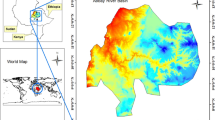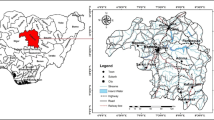Abstract
In India, groundwater assessment units are classified as overexploited areas, critical areas, semi-critical, or safe areas based on the stage of groundwater development and long-term water level trends. Intuitively, in the safe units, wells are expected to function and have good yields. Besides, in the safe units, new wells are expected to be successful. Conversely, the expectation of a successful well or wells with good yields is much lesser in the overexploited units. However, when these expectations are not met in the field, doubts are raised about the quality of assessment and its usefulness, and there is outright distrust on the agencies assessing groundwater resource by the common man as well as on the planners, administrators, and the politicians. Therefore, there is a need to present the results in a way that does not create confusion. One of the methods is to combine the assessment results with aquifer characters using geographic information system (GIS); when this is done, a whole set of newer classes emerge, which can be mapped. These classes are termed as groundwater typologies in this study. Each typology has some characteristics or traits in common, which include basic aquifer character as well as the stage of groundwater development. Thus, a class may be safe, but if the aquifer is poor, then it is separated from a class that is safe and where the aquifer is good and so on. In Andhra Pradesh, which is taken as the case study for this purpose, eight main typologies emerged, and two of these main typologies were further divided into four subtypologies each. This new way of understanding the pattern of groundwater abstraction (using GIS) has a better visual impact. Groundwater typologies are found to be much more rational and useful in developing management strategies, rather than simple listing as overexploited areas, critical areas, semi-critical areas, and safe areas as is commonly done. The typologies so delineated indicate on the map (or table) that balanced usable groundwater is in between 5 and 6 bcm/a as against the estimated balance of 20.5 bcm/a, and it is largely in poor hard rock type of aquifers, which occupy about a third of the area of the state.
Similar content being viewed by others
References
APSGWD (1977). Studies on hydrologic parameters in water balance computations, Andhra Pradesh (151 pp.). Research Series Number 6, Andhra Pradesh State Ground Water Department, Government of AP, Hyderabad.
APSGWD (1987). Borewell directories of different districts of A.P. Unpublished compilations, Andhra Pradesh State Ground Water Department, Government of AP, Hyderabad-63.
APSGWD (2002/2005). Groundwater resource of Andhra Pradesh. Andhra Pradesh State Ground Water Department, Government of AP, Hyderabad-63.
APSGWD (2005). Groundwater resource 2004–2005 AP. Report placed before the State Level Committee for Groundwater Resource Estimation.
APSGWD (2008). Groundwater resource. Andhra Pradesh Unpublished Report, Andhra Pradesh Ground Water Department, Government of AP, Hyderabad-63.
CGWB (MOWR) (2006). Dynamic groundwater resources of India (as of March 2004). Ministry of Water Resources, Government of India.
CWC (MOWR) (2006). Integrated hydrological data book (non-classified river basins). Hydrological Data Directorate, Information Systems Organisation, Water Planning and Projects Wing, Central Water Commission, New Delhi.
DES (2007). Directorate of Economics & Statistics, Govt. of Andhra Pradesh, 410, Khairathabad, Hyderabad-500 004. Retrieved from http://www.apdes.ap.gov.in/Dist@glance/Dist@glance07.pdf.
GEC (1984/1997). Report of ground water estimation committee. Central Ground Water Board, Ministry of Water Resources, Government of India.
Karanth, K. R. (1987). Ground water assessment, development and management. New Delhi: Tata McGraw-Hill.
Karanth, K. R. (1989). Hydrogeology. New Delhi: Tata McGraw-Hill.
Krishnan, M. S. (1960). Geology of India and Burma (4th ed.). Madras: Higginbothams.
Larson, I. (1983). Groundwater in hardrocks. Project 8.6 of International Hydrology Program, Unesco, Paris.
Pradeep Raj (2004). Classification and interpretation of piezometer well hydrographs in part of southeastern peninsular India. Environmental Geology, 46, 808–819.
Pradeep Raj, Nandulal, L., & Soni, G. K. (1996). Nature of aquifer in parts of granitic terrain in Mahabubnagar District, Andhra Pradesh. Journal of the Geological Society of India, 48, 299–307.
Ramakrishnan, M., & Vaidhyanadhan, R. (2008). Geology of India V1 and V2. Geol Soc Ind Bangalore, India.
Ramam, P. K. (1999). Mineral resources of Andhra Pradesh. Geol Soc Ind, Bangalore, India.
Reddy, N. T., & Pradeep Raj, L. (1997). Hydrogeological conditions and optimum well discharge in granitic terrain in parts of Nalgonda District, A.P. Journal of the Geological Society of India, 49, 61–74.
Reddy, N. T., & Pradeep Raj (2008). Hydrogeological conditions and optimum well discharge in granitic terrain in parts of Nalgonda District. In S. Das (Ed.), Hydrogeological research in India. Significant papers from the Journal and memoirs of the Geol Soc India 1959–2008. Bangalore, Geol Soc India.
Shah, T., Sonal, B., Shah, R. K., & Talati, J. (2008). Groundwater governance through electricity supply management: Assessing an innovative intervention in Gujarat, western India. Agricultural Water Management, 95(11), 1233–1242.
Taylor, R., & Howard, K. (2000). A tectono-geomorphic model of the hydrogeology of deeply weathered crystalline rock: Evidence from Uganda. Hydrogeology Journal IAH, 8(3), 279–294
Author information
Authors and Affiliations
Corresponding author
Rights and permissions
About this article
Cite this article
Raj, P. Groundwater resource assessment, categories, and typologies: case study, Andhra Pradesh, India. Environ Monit Assess 173, 777–788 (2011). https://doi.org/10.1007/s10661-010-1422-7
Received:
Accepted:
Published:
Issue Date:
DOI: https://doi.org/10.1007/s10661-010-1422-7




